What is a transferred-basis acquisition?
A transferred-basis acquisition refers to the transfer of assets and liabilities from one corporation to another as part of a reorganization described in section 368(a)(1)(A) or (C) of the Internal Revenue Code. In such cases, the basis of the property in the hands of the transferee corporation is generally the same as the basis of the property in the hands of the transferor corporation.
When must an S corporation file Form 1120-S?
An S corporation must file Form 1120-S by the 15th day of the third month following the end of its tax year. For example, if the S corporation’s tax year is the calendar year, it must file by March 15.
What is a built-in gains tax?
A built-in gains tax is an additional tax that applies to certain C corporations converting to S corporation status. It applies to the unrealized appreciation in the value of assets held by the corporation at the time of conversion, and it's calculated based on the difference between the FMV of the assets and their adjusted basis.
What is a separate gain or loss recognition period?
A separate gain or loss recognition period is a specific period during which an S corporation must recognize certain gains and losses on its assets. It usually lasts for 10 years after the corporation's election to be treated as an S corporation.
What are the two methods of figuring recognized built-in gain?
The two methods of figuring recognized built-in gain are: (1) using a fixed 20% rate, or (2) using the overall interest charge method. Both methods apply the 3.8% net investment income tax to certain capital gains and losses.
How do I allocate section 1204 credit?
To allocate section 1204 credit, follow these steps: (1) Calculate the total amount of deferred foreign income included in the corporation’s income for the tax year. (2) Determine the amount of foreign income that can be claimed under the control rule. (3) Divide the total section 1204 credit by the maximum amount of foreign income eligible for the credit. (4) Allocate the remainder of the credit to the corporation’s other income.
What is a qualified subchapter S trust?
A qualified subchapter S trust is an irrevocable trust that meets certain requirements and allows its grantor to deduct up to 30% of the trust's income in determining the S corporation’s tax liability.
When does an S corporation's tax year start?
An S corporation's tax year starts on the first day of a month and ends on the last day of the same month in the following year. For example, if an S corporation’s tax year is January 1st, its tax year will end on December 31st.
What is the purpose of Schedule D (Form 1120-S) for an S corporation?
Schedule D (Form 1120-S) is used by an S corporation to calculate and report the built-in gains tax. It helps determine the taxable income, net operating loss carryforward and business credit carryforward or acquired in a transferred-basis acquisition, and calculates the section 1374(b)(2) deduction and section 1374(b)(3) credit.
What is the built-in gains tax?
The built-in gains tax is a provision in the Internal Revenue Code that applies to the sale or exchange of certain assets by an S corporation. It requires the recognition and payment of tax on the built-in gain (the difference between the FMV and adjusted basis of the asset) as if the corporation were a C corporation for the period during which the assets were held before the conversion to S status.
What is a recognized built-in loss?
A recognized built-in loss is a loss recognized by an S corporation during the recognition period on the disposition of an asset. It includes any loss attributable to the period before the applicable recognition period and does not exceed the excess of the adjusted basis of the asset at the beginning of the applicable recognition period over the FMV of the asset as of that time.
What should be shown on line 17 of Schedule D (Form 1120-S) for an S corporation?
Taxable income figureed in accordance with section 1375(b)(1)(B), which is generally figured in the same manner as taxable income for line 9 of the Excess Net Passive Income Tax Worksheet for Line 22a in the Instructions for Form 1120-S.
What is a separate group of assets for an S corporation?
A separate group of assets refers to assets that were held by different corporations before their merger, or assets that are held in connection with trades or businesses that were operated as separate entities before becoming part of the S corporation.
What deduction should be entered on line 19 of Schedule D (Form 1120-S) for an S corporation?
The section 1374(b)(2) deduction, which is any net operating loss (NOL) carryforward or capital loss carryforward arising in tax years for which the corporation was a C corporation or acquired in a transferred-basis acquisition.
What credit should be entered on line 22 of Schedule D (Form 1120-S) for an S corporation?
The section 1374(b)(3) credit, which is any general business credit arising in tax years for which the corporation was a C corporation or acquired in a transferred-basis acquisition.
Which S corporation tax form should I use?
Use Form 1120-S, U.S. Corporation Income Tax Return. This form is used by S corporations to report their income, deductions, credits, and tax liability.

